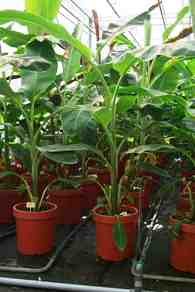Articles
Rejuvenation of banana tissue culture
Contributors to this page: Bioversity International, Belgium (Ines Van den Houwe); IITA, Nigeria (Dominique Dumet, Badara Gueye).
|
Greenhouse regeneration |
Why regeneration/rejuvenation of stored tissue cultures
Regeneration and rejuvenation of an accession involves the transfer of the accessions to the greenhouse and field in order to check their trueness-to-type (identity and conformity). Rejuvenation is the replacement of the tissue cultures in storage by a set of quality material derived from the verified material. Often both activities are combined.
Using field established plants for harvesting shoot tips to rejuvenate the accession in storage would require re-indexation for viruses, as the plants could have been exposed to viruses.
In order to rejuvenate an accession without having to go through re-indexation of the material, in vitro plants from the accession should first be established in the greenhouse.
It is recommended that this standard procedure involving regeneration and rejuvenation of accessions should be carried out for any accession being maintained continuously in vitro for more than ten subculture cycles (or ten years in MTS):
Regeneration of plants in the greenhouse
- From the set of cultures in storage, a representative sample of five cultures should be randomly selected and regenerated into five rooted plantlets. These plants should be planted out in the greenhouse.
Decapitation of suckers
- Approximately nine months after the planting date, when the sucker diameter is at least 4.5 cm, greenhouse plants should be decapitated in order to stimulate the outgrowth of new shoots.
- The corms should be taken out of the pots and the adhering soil must be gently removed, without damaging the sleeping buds on the corm.
- The roots should be cut back to about 5 cm from the corm surface, leaving the corm tissue and dormant buds intact.
- Leaf sheaths should be cut back to about 5cm above the corm leaving all lateral buds covered.
- The apical shoot tip should be removed by excising a cube of tissue of 2x2x6 cm³ from the upper centre of the corm.
- The disinfection, shoot tip culture initiation and bacterial indexing procedures that must be applied next are described in sample procedures.
- In order to avoid fungal deterioration of the prepared corms, the basal part must be sprayed with a fungicide and the upper part must be protected at the cut surfaces with a thin layer of a Vaseline-fungicide mixture.
- Corms should be ‘replanted’ in five litre pots filled with a mixture of peat and soil, and topped up with a 10 cm layer of vermiculite.
- The decapitated corms should be kept in a greenhouse at an ambient temperature ranging between 18°C (night) and 26°C (day) and a RH of 70-90%.
- Four months after decapitation, one single sucker per accession, producing the highest number of new and normal looking shoots must be selected.
- Shoots of at least one centimetre are suitable for shoot tip isolation and tissue culture initiation.
- All shoot tips should be harvested and re-initiated in vitro following the protocols described for sample procedures.
In vitro plants derived from two shoot tips must be sent to the field for verification. If these plants are confirmed true-to-type (after two growing cycles), the remaining shoot-tips from the same sucker can be further multiplied in vitro and replace the old set of replicates in cold storage.
The whole regeneration/rejuvenation cycle takes about 20-22 months.
Field verification and characterization of accessions
- Accessions must be verified for their trueness-to-type in the field. Ideally, they are grown in a field collection next to the original mother plant and observed for their morphological characteristics (using a minimal set of descriptors) during two subsequent growth cycles.
- Accessions that are confirmed to possess the same characteristics as the original genotype can be declared true-to-type and they are renewed in MTS following the rejuvenation process described above.
- Accessions identified as off-types with no value, or accessions which are found to be mislabelled (ML), must be discarded and replaced with the original true-to-type material from the donor source.
References and further reading
Van den Houwe I, Panis B, Arnaud E, Markham R, Swennen R. 2006. The management of banana (Musa spp.) genetic resources at the IPGRI/INIBAP gene bank: The conservation and documentation status. In: Segers H, Desmet P, Baus E, editors. Tropical Biodiversity: Science, Data, Conservation. Proceedings of the 3rd GBIF Science Symposium. Brussels, Belgium, 18-19 April 2005. pp.141-150.
Comments
- No comments found





Leave your comments
Post comment as a guest